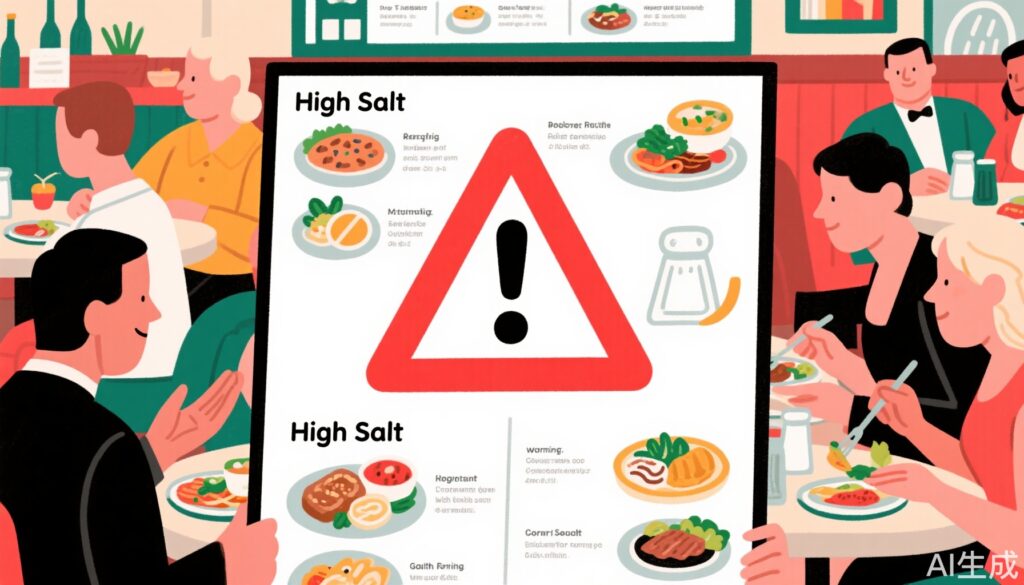Highlight
- High salt intake increases cardiovascular risk; many out-of-home foods contain excessive salt.
- Two UK randomised controlled trials, one online and one in a real-world restaurant, tested the effectiveness of salt warning labels on packaged foods and menus.
- Salt warning labels—especially red triangle icons—were perceived as significantly more effective than controls in discouraging salt consumption and promoting salt awareness.
- Real-world findings indicate labelled menus substantially increase consumers’ consideration of salt content when ordering.
Study Background and Disease Burden
Excessive dietary salt intake is a well-established modifiable risk factor for hypertension and cardiovascular disease (CVD), which remain leading causes of morbidity and mortality worldwide. Despite public health efforts, salt intake often exceeds recommended limits, largely due to high salt content in commonly consumed out-of-home foods such as restaurant meals and convenience packaged snacks. In the United Kingdom, this sector accounts for a notable proportion of daily salt intake, contributing to sustained cardiovascular risk at the population level.
Policy options to mitigate high salt consumption in out-of-home settings are limited. Voluntary reformulation and informational campaigns have had variable success. An emerging approach is to implement direct warning labels on packaged food items and restaurant menus that signal high salt content to consumers. However, robust evidence from randomised controlled trials (RCTs) demonstrating the effectiveness of salt warning labels is scarce. This study aims to fill that evidence gap by evaluating consumer responses to salt warning labels through both an online RCT simulating food purchasing scenarios and a pragmatic RCT evaluating actual consumer behavior in a UK restaurant.
Study Design
The research comprised two separate RCTs conducted in the UK:
1. Online RCT (Study 1): Participants (n=2549), representative of the UK adult population by age, sex, and education, were recruited if they were English-fluent adults, current UK residents, frequent consumers of supermarket sandwiches, snacks, and out-of-home meals (at least monthly), excluding pregnant or breastfeeding individuals and those with major dietary restrictions. They were randomly assigned equally to one of four salt warning label designs (red triangle, black triangle, red octagon, black octagon) or a control group displaying a QR code.
Subjects completed three packaged food purchasing scenarios and three restaurant ordering scenarios, presented online. The primary outcome was perceived message effectiveness measured on an adapted University of North Carolina scale, capturing the labels’ impact on discouraging salt intake.
2. Real-world RCT (Study 2): Participants (n=465) who ate out at least once monthly were randomized by block (block size ~50) to receive lunch from menus with or without red triangle salt warning labels adjacent to high-salt items in a real UK restaurant setting.
Exclusions included individuals with severe dietary allergies and veganism. Following meal purchase and consumption, participants completed questionnaires assessing perceived label effectiveness and salt-related awareness.
All participants were masked to the study hypotheses and compensated. Study 2 is registered at ClinicalTrials.gov (NCT06458270).
Key Findings
Study 1 – Online RCT:
– Out of 2549 randomized participants, 2391 were included in final analysis after exclusions.
– Demographics: approximately equal gender distribution (50% female, 49% male).
– All four salt warning label designs were significantly perceived as more effective in discouraging salt intake compared to control.
– Mean perceived message effectiveness differences vs control:
– Packaged food scenarios: 1.23 (95% CI 1.12–1.34; p<0.0001)
– Menu scenarios: 1.22 (95% CI 1.11–1.33; p<0.0001)
– The red triangle label was particularly impactful, indicating strong consumer recognition.
Study 2 – Real-world RCT:
– 465 participants randomized; 454 analyzed after exclusions.
– Demographics: 54% female, 45% male.
– The red triangle salt warning label on menus yielded a significant increase in perceived message effectiveness compared to the standard menu, with a mean difference of 1.00 (95% CI 0.79–1.18; p<0.0001).
– Participants exposed to the labelled menu had dramatically higher likelihood of considering salt content when ordering (odds ratio 19.50, 95% CI 8.24–46.16; p<0.0001).
These robust findings from complementary methodologies highlight that salt warning labels are effective at enhancing consumer awareness and can discourage high-salt food choices, thus holding promise as a population-level intervention.
Expert Commentary
The study by Evans et al. represents a landmark evidence base addressing a critical public health gap: the impact of salt warning labels in real-world consumer food environments. The inclusion of both simulated and actual dining contexts strengthens the validity and applicability of the findings.
Nonetheless, the studies primarily measured perceived message effectiveness and salt awareness—not direct reductions in salt consumption or clinical outcomes. While behavioural intentions are positive proxies, future trials should incorporate objective measures such as sodium intake biomarkers and long-term health endpoints to consolidate policy recommendations.
Moreover, variability in label design and placement warrants further exploration to optimize consumer impact and minimize potential label fatigue. Cross-cultural applicability beyond the UK remains to be established, considering differing dietary patterns and regulatory environments.
Overall, these data provide compelling support for the integration of clear salt warning labels on menus and packaged food labeling frameworks as part of national strategies to reduce dietary salt intake and cardiovascular disease burden.
Conclusion
High salt consumption is a key modifiable cardiovascular risk factor driven in large part by excessive salt in out-of-home and convenience foods. This dual randomised controlled trial in the UK demonstrates that salt warning labels—particularly easily recognizable symbols such as red triangles—increase consumer awareness and discourage salt intake intentions.
Menu labeling in real food service environments produced marked improvements in consumers’ likelihood of considering salt content, underscoring the potential for meaningful real-world impact.
These findings advocate for policy adoption of salt warning labels within the out-of-home food sector as a scalable public health measure. Further real-world research is needed to optimize label characteristics and confirm downstream reductions in salt consumption and related health outcomes.
References
Evans R, Brealey J, Clarke N, Falbe J, Finlay A, Jones A, Thorp P, Witham B, Witkam R, Robinson E. Salt warning labels in the out-of-home food sector: online and real-world randomised controlled trials in the UK. Lancet Public Health. 2025 Aug;10(8):e656-e667. doi: 10.1016/S2468-2667(25)00143-4. PMID: 40738552.
World Health Organization. Guideline: Sodium intake for adults and children. Geneva: WHO; 2012.
He FJ, MacGregor GA. Salt reduction reduces cardiovascular risk: meta-analysis of outcome trials. Lancet. 2011;378(9789):380-2.
Funding
The studies were funded by the National Institute for Health and Care Research Oxford Health Biomedical Research Centre and the European Research Council.
—


